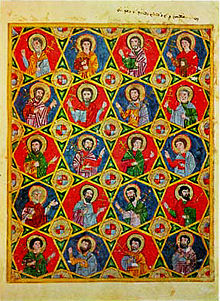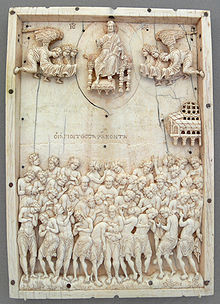Forty Martyrs of Sebaste
| Forty Martyrs of Sebaste | |
|---|---|
 Icon of The Forty Martyrs of Sebaste | |
| Died | c. 320 Anno Domini, Sebaste (modern-day Sivas, Turkey) |
| Martyred by | Emperor Licinius |
| Means of martyrdom | Exposure |
| Venerated in |
|
Martyr's palm | |
| Patronage | Persecuted Christians |

The Forty Martyrs of Sebaste or the Holy Forty (Ancient/Katharevousa Greek Ἅγιοι Τεσσαράκοντα; Demotic: Άγιοι Σαράντα) were a group of Roman soldiers in the Legio XII Fulminata (Armed with Lightning) whose martyrdom in the year 320 AD for the Christian faith is recounted in traditional martyrologies.
They were killed near the city of Sebaste, in Lesser Armenia (present-day Sivas in Turkey), victims of the persecutions of Licinius who, after 316, persecuted the Christians of the East. The earliest account of their existence and martyrdom is given by Bishop Basil of Caesarea (370–379) in a homily he delivered on their feast day.[2] The Feast of the Forty Martyrs is thus older than Basil himself, who eulogised them only fifty or sixty years after their deaths.
Martyrdom

According to Basil, forty soldiers who had openly confessed themselves Christians were condemned by the prefect to be exposed naked upon a frozen
Names

The Menaion of the Eastern Orthodox Church lists the names of the Forty Martyrs as follows:
- Hesychius, Meliton, Heraclius, Smaragdus, Domnus, Eunoicus, Valens, Vivianus, Claudius, Priscus, Theodulus, Euthychius, John, Xanthias, Helianus, Sisinius, Cyrion, Angius, Aetius, Flavius, Acacius, Ecditius, Lysimachus, Alexander, Elias, Candidus, Theophilus, Dometian, Gaius, Gorgonius, Eutyches, Athanasius, Cyril, Sacerdon, Nicholas, Valerius, Philoctimon, Severian, Chudion, and Aglaius.[4]
According to Antonio Borrelli, their names were:
- Aetius, Eutychius, Cyrius, Theophilus, Sisinnius, Smaragdus, Candidus, Aggia, Gaius, Cudio, Heraclius, John, Philotemon, Gorgonius, Cirillus, Severianus, Theodulus, Nicallus, Flavius, Xantius, Valerius, Aesychius, Eunoicus, Domitian, Domninus, Helianus, Leontius (Theoctistus), Valens, Acacius, Alexander, Vicratius (Vibianus), Priscus, Sacerdos, Ecdicius, Athanasius, Lisimachus, Claudius, Ile, Melito and Eutychus (Aglaius).[5]
Veneration
Early
A church was built at
In the East

The memory of the Forty Martyrs is widespread all over the East. The
In Syria, the Armenian Cathedral of Aleppo and the Greek Orthodox Cathedral of Homs are dedicated to the Forty Martyrs.
The
There is a pious custom of baking “skylarks” (pastries shaped like skylarks) on this day, because people believed that birds sing at this time to announce the arrival of spring.[3]
A prayer mentioning the Forty Holy Martyrs of Sebaste is also placed in the Orthodox Wedding Service (referred to as a "crowning") to remind the bride and groom that spiritual crowns await them in Heaven also if they remain as faithful to Christ as these saints of long ago.
In Orthodox art

Byzantine artists were fascinated with the subject that allowed them to graphically show human despair. The Martyrs were typically represented at the point when they were about to freeze to death, "shivering from the cold, hugging themselves for warmth, or clasping hands to their faces or wrists in pain and despair".[11] This is particularly evident in the large 10th-century ivory plaque from the Bode Museum and the Palaiologan portable mosaic set in wax, from Dumbarton Oaks.
The subject remains popular among Orthodox
In the West
Special devotion to the Forty Martyrs of Sebaste was introduced at an early date into the West. Bishop
The Church of Santa Maria Antiqua in the Roman Forum, built in the fifth century, contains a chapel, built like the church itself on an ancient site, and consecrated to the Forty Martyrs. A sixth or seventh-century mural there depicts their martyrdom. The names of the confessors, as we find them also in later sources, were formerly inscribed on this fresco.
Acts of these martyrs, written subsequently, in Greek, Syriac and Latin, are yet extant, also a "Testament" of the Forty Martyrs.
In the West, the feast of the Forty Martyrs of Sebaste was celebrated on 10 March and suppressed in 1969.[1] In some countries, for example Poland and Slovenia, 10 March is named Martyrs' Day as a relict of the feast and celebrated as Men's Day by some people.[12][13] The International Men's Day takes place on 19 November.
See also
Further reading
- Of the Forty Soldiers (Mar. 9) in "Ælfric's Lives of Saints", by Ælfric of Eynsham London, Pub. for the Early English text society, by N. Trübner & co. (1881).
- Kirsch, Johann Peter (1909). . In Herbermann, Charles (ed.). Catholic Encyclopedia. Vol. 6. New York: Robert Appleton Company.
References
- ^ a b "Forty Martyrs of Sebaste". Oxford Reference. Retrieved 10 March 2024.
- ^ Homilies xix in P.G., XXXI, 507 sqq.
- ^ a b "Martyr Acacius of the Holy 40 Martyrs of Sebaste". oca.org.
- ^ (Slavonic) http://puhtitsa.ee/library/liturgical_texts/menaion/Daily_Menaion/07_March/mar09.pdf
- ^ (in Italian) Santi Quaranta Martiri di Sebaste
- ^ P. G., XLVI, 749 sqq., 773 sqq.
- ^ Hymni in SS. 40 martyres.
- ^ Historia Ecclesiastica, IX, 2
- ^ 40 shenjtoret, zbulohen 6 vaska pagëzimi, befasohen arkeologët, Fatmira Nikolli Archived 2014-04-17 at the Wayback Machine
- ^ "Feast of the Holy Forty Martyrs in Štip". unesco.org. Retrieved 2015-12-23.
- ^ The Metropolitan Museum of Art
- ^ Slatinšek, Suzana (November 2011). "Mednarodni dan žena, mednarodni dan moških / Materinski dan, dan očetov". Prometnik.
- ^ Lasota-Krawczyk, Justyna (6 March 2024). "Dzień Mężczyzn: Już w piątek święto wszystkich panów" [Men's Day: A Celebration of All Men on Friday]. RMF24 (in Polish).
External links
- [1] 40 Holy Martyrs of Sebaste - Eastern Orthodox synaxarion
